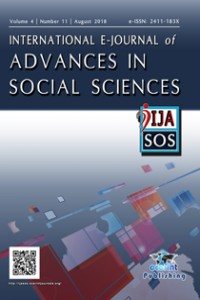Research Article
Year 2018,
Volume: 4 Issue: 11, 455 - 462, 31.08.2018
Abstract
References
- Al-Qummi, B. (2012). Essence of Shia Faith. Sargodha: Maktaba Sibtain. Carus, P. (1904, October). Definition of Religion. The Monist, Vol. 14, No. 5, pp. 766-770. Haydon, A. E. (1922, November). Comparative Religion to History of Religions. The Journal of Religion, Vol. 2, No. 6 , pp. 577-587. Hoyt, S. F. (1912). The Etymology of Religion. Journal of the American Oriental Society, Vol. 32, No. 2, 126-129. Jordan, L. H. (1908). The Method and Scope of Comparative Religion. International Congress of Religions (pp. 3-20). London: Oxford University Press. Levenson, J. D. (2012). Inheriting Abraham: The Legacy of the Patriarch in Judaism, Christianity, and Islam. NJ, US: Princeton University Press. Peters, F. E. (2004). The Children of Abraham. NJ, US: Princeton University Press. Ross, S. (1964, April). Scientist: The story of a word. Annals of Science, 18:2, pp. 65-85. Snell, M.-M. (1896, September). The Nature and Scope of the Science of Comparative Religion. The Biblical World, Vol. 8, No. 3, pp. 203-210. Ṭabāṭabāʾī, M. Ḥ. (1989). Islamic Teachings: An Overview. NY, US: Mostazafan Foundation; 1st edition. Telushkin, J. (1991). Jewish Literacy: The Most Important Things to Know About the Jewish Religion, Its People and Its History. NY, US: William Morrow and Co.
Year 2018,
Volume: 4 Issue: 11, 455 - 462, 31.08.2018
Abstract
Our
research has surveyed the philological origins of the word ‘science’ and
‘religion’. Furthermore, it has re-examined the definitions of ‘The Science of
Religion’ and ‘The Science of Comparative Religion’. Building on this
foundation, the author compared the major similarities and differences between
the Jewish, Christian and Islamic Religions, especially via the lens of
Monotheism, exploring the Jewish Shema, Christian Niceno-Constantinopolitan
Creed, and Islam’s Tawheed. This new research aims to contribute to a better
understanding of our three major monotheistic religions.
References
- Al-Qummi, B. (2012). Essence of Shia Faith. Sargodha: Maktaba Sibtain. Carus, P. (1904, October). Definition of Religion. The Monist, Vol. 14, No. 5, pp. 766-770. Haydon, A. E. (1922, November). Comparative Religion to History of Religions. The Journal of Religion, Vol. 2, No. 6 , pp. 577-587. Hoyt, S. F. (1912). The Etymology of Religion. Journal of the American Oriental Society, Vol. 32, No. 2, 126-129. Jordan, L. H. (1908). The Method and Scope of Comparative Religion. International Congress of Religions (pp. 3-20). London: Oxford University Press. Levenson, J. D. (2012). Inheriting Abraham: The Legacy of the Patriarch in Judaism, Christianity, and Islam. NJ, US: Princeton University Press. Peters, F. E. (2004). The Children of Abraham. NJ, US: Princeton University Press. Ross, S. (1964, April). Scientist: The story of a word. Annals of Science, 18:2, pp. 65-85. Snell, M.-M. (1896, September). The Nature and Scope of the Science of Comparative Religion. The Biblical World, Vol. 8, No. 3, pp. 203-210. Ṭabāṭabāʾī, M. Ḥ. (1989). Islamic Teachings: An Overview. NY, US: Mostazafan Foundation; 1st edition. Telushkin, J. (1991). Jewish Literacy: The Most Important Things to Know About the Jewish Religion, Its People and Its History. NY, US: William Morrow and Co.
There are 1 citations in total.
Details
| Primary Language | English |
|---|---|
| Journal Section | Research Article |
| Authors | |
| Publication Date | August 31, 2018 |
| Submission Date | June 3, 2018 |
| Published in Issue | Year 2018 Volume: 4 Issue: 11 |
Contact: ijasosjournal@hotmail.com
The IJASOS Journal's site and its metadata are licensed under CC BY
Published and Sponsored by OCERINT International © 2015- 2025

